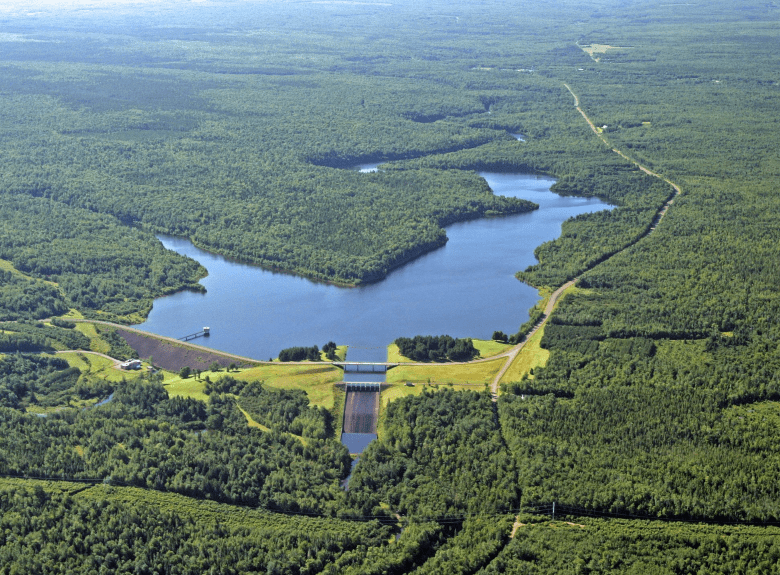Cyanobacteria (Blue-green algae)
Cyanobacteria (formerly called Blue-green algae) are photosynthetic bacterial organisms, naturally found in many types of water systems including lakes, rivers and wetlands. The region’s first major cyanobacterial bloom occurred in 2017; many actions have been launched to mitigate future blooms.
506-853-3333
info [at] moncton.ca (info[at]moncton[dot]ca)

What are cyanobacteria?
Cyanobacteria are naturally occurring microscopic organisms found in both fresh and salt water. Under conditions such as warm water temperatures, high nutrient loads, and other influences, cyanobacteria can multiply quickly and create blooms. These blooms can sometimes produce harmful toxins. Although blooms can occur at any time of year, they are more common in summer or early fall.
FAQ
What does a bloom look like?
Colours may vary depending on the species of cyanobacteria, however they are typically on a green tint. There may be an earthy, musty, or stale odour as well. When the cyanobacteria rise to the surface it is often described as if the surface of the water has been painted green.
What causes a bloom?
Blooms are triggered by excessive nutrients. This can be further accelerated by warm weather, calm conditions, and stagnant water.
Why are cyanobacteria a problem?
When they occur in excess they can replace other species, creating an imbalance in the ecosystem and deprive other species of food. There are also many varieties and each one reacts differently to treatment.
What can be done to control blooms?
The ultimate solution is to control the input of nutrients. There are products that might be able to help treat a body of water that has a cyanobacterial bloom.
How and when was it detected in the Tower Road reservoir?
The first visible signs of cyanobacteria appeared on September 12, 2017 during routine maintenance and monitoring of the dam and spillway. On September 15, test results confirmed the presence of cyanobacteria.
Although cyanobacteria have been detected annually, no blooms developed again until August 29, 2022.
What is being done to resolve the issue?
The City of Moncton is pursuing mitigation measures both for the watershed and the water treatment plant. The watershed mitigation recommendation has not yet been approved by the applicable regulatory bodies; further research has been requested of the product supplier. The water treatment plant is being upgraded in various phases Phase 1, which was to address the hydraulic capacity of the plant (prevent cyanobacteria from plugging within the treatment process) is complete. Phase 2, which is to mitigate against toxins that cyanobacteria are capable of producing, is underway and is expected to be completed by early 2026.
Could the City have done something to avoid this situation?
Cyanobacteria appear naturally and often when the weather is very hot and dry. There is very little that could have prevented this from happening. The reservoirs at the Irishtown Nature Park and McLaughlin have both experienced cyanobacteria blooms in the past. Many other municipalities in NB, across Canada and around the world have also had this issue; it is a naturally occurring problem.
What will be the cost to fix the issue? How long will it take?
The water treatment plant is being upgraded in phases. The cost for Phase 1 was $6M, including assistance from both the federal government (40%) and the provincial government (33%). The cost for Phase 2 mitigation was approved for $22M under a similar funding agreement.
Will it affect our drinking water supply?
Cyanobacteria are present in both the Turtle Creek reservoir (our primary drinking water supply) and in the Tower Road reservoir (second supply that opened in 2014). At the moment, conditions indicate that a bloom may recur in the Tower Road reservoir, as has occurred in 2017 and 2022. At this time, residents and pets can consume the water. Should there be a change in the situation, however, the public will be notified immediately.
Is the water treatment plant doing anything? Are they affected?
Water treatment plant operators are continuing normal operations as well as daily monitoring and sampling. They are also working with the City of Moncton to prepare for the potential impact of a cyanobacterial bloom.
How will we be notified if we are no longer able to drink the water?
The City of Moncton and the Department of Health will notify residents of the tri-community immediately. This will be done through a media advisory, social media, websites and Moncton will also send it through their Moncton Alerts program.
I have a well, am I also affected?
No, homeowners with wells are not affected by cyanobacteria
Helpful Information
- City of Moncton - Water Conservation
- Government of New Brunswick- Blue Green Algae
- Government of Canada - Canadian Drinking Water Guidelines